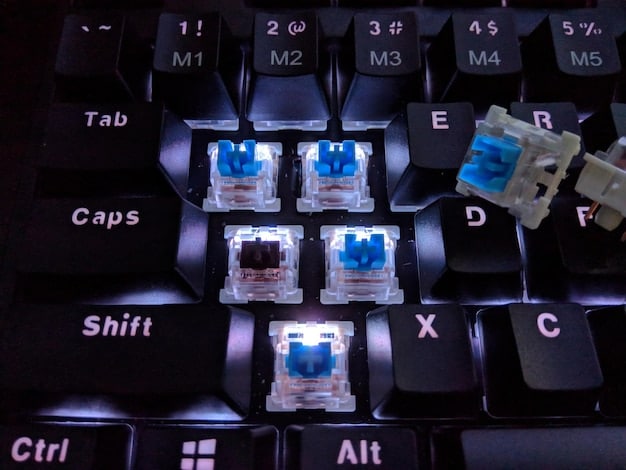The Truth About Mechanical Keyboard Switches: Choosing the Right One for Your Playstyle

The Truth About Mechanical Keyboard Switches: Choosing the Right One for Your Playstyle involves understanding the nuances of different switch types—linear, tactile, and clicky—and how they align with your gaming or typing preferences. This knowledge ensures a comfortable and efficient experience.
Mechanical keyboards have surged in popularity, and at the heart of these devices lie the switches. Whether you’re a hardcore gamer, a coding enthusiast, or someone who simply enjoys the feel of a responsive keyboard, understanding the different types of mechanical keyboard switches is crucial. Navigating this can be tricky, but the truth about mechanical keyboard switches: choosing the right one for your playstyle comes down to understanding your own preferences.
This guide aims to demystify the world of mechanical keyboard switches, helping you make an informed decision that enhances your overall experience. Consider this your comprehensive guide to switch selection.
Understanding Mechanical Keyboard Switches: The Basics
Before diving into specific types and their characteristics, let’s cover some fundamental aspects of mechanical keyboard switches. Understanding these concepts will provide a solid base as we explore the truth about mechanical keyboard switches: choosing the right one for your playstyle.
What Makes a Switch “Mechanical”?
Unlike membrane keyboards, which use a rubber dome to register keystrokes, mechanical keyboards employ individual, physical switches beneath each keycap. These switches consist of several parts: a housing, a stem, a spring, and metal contacts. When a key is pressed, the stem moves, compressing the spring and causing the metal contacts to connect, registering the keypress. This tactile and audible feedback is one of the main reasons many users prefer mechanical keyboards. This construction allows for more consistent and precise input, enhancing overall typing and gaming accuracy.
Key Switch Components
- Housing: The outer shell of the switch, providing structure and stability.
- Stem: The part that moves when you press the key, determining the feel of the switch.
- Spring: Provides resistance and returns the key to its original position after being pressed.
- Contacts: Metal parts that connect to register the keypress.
Understanding these components provides a foundation for appreciating the nuances of different switch types and how they cater to varying needs.
In conclusion, understanding the basics of mechanical keyboard switches, including their construction and key components, sets the stage for making informed decisions tailored to your specific needs and preferences when choosing the truth about mechanical keyboard switches: choosing the right one for your playstyle.
Linear Switches: Smooth and Swift
Linear switches are known for their smooth and consistent keystroke. Without any tactile bump or audible click, these switches provide a seamless experience. This attribute makes them a favorite among gamers and typists who prioritize speed and responsiveness. Let’s explore the truth about mechanical keyboard switches: choosing the right one for your playstyle when it comes to linear switches.

Popular Linear Switches
Several linear switches are widely recognized for their performance and reliability.
- Cherry MX Red: Known for their light actuation force (45g), Cherry MX Reds are a popular choice for gaming due to their quick response and smooth feel.
- Cherry MX Black: These switches require a higher actuation force (60g), providing a heavier feel that some users prefer for typing and preventing accidental key presses.
- Gateron Yellow: Often considered a more affordable alternative to Cherry MX Reds, Gateron Yellows offer a similar linear feel with a slightly smoother action.
Benefits of Linear Switches
These switches offer several advantages, especially for certain applications. One of the primary benefits of these switches is their swiftness. Linear switches allow for rapid key presses, which is crucial in fast-paced games where quick reactions are essential.
In summary, linear switches are ideal for those who prioritize speed and a smooth, uninterrupted keystroke, making them a solid choice when considering the truth about mechanical keyboard switches: choosing the right one for your playstyle.
Tactile Switches: The Bump That Tells You
Tactile switches provide a noticeable bump when the key is actuated, giving users a clear indication that the keypress has registered. This tactile feedback can be incredibly satisfying for typists. Let’s delve into the truth about mechanical keyboard switches: choosing the right one for your playstyle with a focus on tactile switches.
Understanding Tactile Feedback
Tactile switches bridge the gap between linear and clicky switches, offering a balance of responsiveness and feedback. The tactile bump occurs at the point of actuation, allowing users to feel exactly when the keypress is registered without the noise of a clicky switch. This can reduce typing errors and improve overall accuracy.
Popular Tactile Switches
Several tactile switches are lauded for their responsiveness and distinct feedback, each offering a slightly different typing experience.
- Cherry MX Brown: A versatile option, Cherry MX Browns are commonly used for both typing and gaming. The light tactile bump is noticeable, but not too distracting.
- Glorious Panda: Known for their significant and pronounced tactile bump, Glorious Pandas offer a premium tactile experience.
- Gateron Brown: A more affordable option, Gateron Browns provide a similar tactile feel to Cherry MX Browns but often at a lower price point.
Therefore, tactile switches are excellent for those who appreciate feedback without excessive noise, making them ideal for both typing and gaming scenarios when considering the truth about mechanical keyboard switches: choosing the right one for your playstyle.

Clicky Switches: The Sound of Satisfaction
Clicky switches are characterized by both a tactile bump and an audible click when the key is pressed. This combination provides both tactile and auditory feedback, making each keypress distinct and satisfying. Understanding the truth about mechanical keyboard switches: choosing the right one for your playstyle includes considering the unique experience of clicky switches.
The Appeal of Auditory Feedback
The audible click provides an extra layer of confirmation that a keypress has been registered, enhancing the overall typing experience. This auditory feedback can be particularly enjoyable for those who appreciate a more mechanical and responsive feel. Additionally, the sound can help improve typing rhythm and accuracy.
Popular Clicky Switches
Several clicky switches are recognized for their distinctive sound and tactile feedback. These switches offer a unique combination of feel and sound that can greatly enhance the typing experience, depending on personal preference.
Whether you are looking for something that offers audible satisfaction while playing games or working, clicky switches will provide that distinct feel. Here are some popular options.
- Cherry MX Blue: Known for their high-pitched click and noticeable tactile bump, Cherry MX Blues are a classic choice for those who enjoy a loud and responsive switch.
- Kailh Box White: These switches offer a crisp, clean click with a slightly lighter actuation force compared to Cherry MX Blues.
- Razer Green: Exclusively used in Razer keyboards, these switches provide similar tactile and auditory feedback to Cherry MX Blues, designed for gaming.
In conclusion, clicky switches are perfect for users who love both tactile and auditory feedback, providing a unique and satisfying typing and gaming experience. This makes them a strong contender when weighing the truth about mechanical keyboard switches: choosing the right one for your playstyle.
Factors to Consider When Choosing a Switch
When selecting a mechanical keyboard switch, several factors come into play, influencing your overall experience. Understanding these aspects can help you narrow down your options and choose the perfect switch for your needs. Exploring the truth about mechanical keyboard switches: choosing the right one for your playstyle involves considering these key elements.
Actuation Force
Actuation force refers to the amount of pressure required to register a keypress. Lighter switches, such as Cherry MX Red (45g), require less force, making them ideal for users who want a quick and responsive feel. Heavier switches, like Cherry MX Black (60g), need more force, which can help prevent accidental key presses. Understanding your preferred actuation force is crucial for comfort and accuracy.
Key Travel
Key travel is the distance a key travels from its resting position to the point of actuation. Standard key travel is around 4mm, but some switches may have shorter or longer travel distances. Shorter travel can lead to quicker key presses, while longer travel may provide a more substantial feel.
When it comes to keyboards, a small change can make all the difference. Make sure you are optimizing your feel when picking the right switch!
Noise Level
The noise level of a switch is an important consideration, especially if you work in a shared environment or prefer a quieter typing experience. Linear switches are generally the quietest, while clicky switches are the loudest. Tactile switches fall somewhere in the middle.
Intended Use
Consider how you’ll primarily use your keyboard. Gamers often prefer linear switches for their speed and responsiveness, while typists may lean towards tactile switches for improved accuracy and feedback. If you do both, a versatile tactile switch like Cherry MX Brown might be the best option.
Evaluating these factors ensures that you select a switch that aligns with your preferences and needs, enhancing your overall computing experience and helping you discover the truth about mechanical keyboard switches: choosing the right one for your playstyle.
| Key Aspect 💡 | Brief Description 📝 |
|---|---|
| Linear Switches 🕹️ | Smooth, consistent keystrokes without tactile feedback. Great for gaming! |
| Tactile Switches ✍️ | Noticeable bump when actuated, ideal for typing and accuracy. |
| Clicky Switches 🔊 | Tactile bump and audible click for distinct, satisfying feedback. |
| Actuation Force 💪 | Pressure needed to register a keypress; lighter for speed, heavier for precision. |
Frequently Asked Questions
Linear switches offer a smooth, consistent keystroke without any feedback. Tactile switches provide a noticeable bump when the key is pressed, while clicky switches offer both a bump and an audible click, giving a more pronounced feel.
If you prefer a light and quick feel, opt for switches with a lower actuation force (45-55g). If you prefer a heavier, more deliberate feel to prevent accidental key presses, choose switches with a higher actuation force (60g or more).
Absolutely! Linear switches can offer a competitive edge due to their speed and responsiveness, while tactile switches can improve accuracy. Choosing a switch that aligns with your playstyle can significantly enhance your gaming experience.
Mechanical keyboards provide a more tactile and responsive feel, with each key having its own mechanical switch. This leads to greater precision and durability, making them preferred by gamers and typists despite being pricier than membrane keyboards.
Many electronics or specialty keyboard stores offer switch testers that allow you to try out various switch types. Additionally, some online retailers offer individual switches for purchase, enabling you to test them on your own keyboard.
Conclusion
Selecting the right mechanical keyboard switch is a personal journey that blends technical understanding with individual preferences. By understanding the differences between linear, tactile, and clicky switches, and considering factors like actuation force and noise level, you can find a switch that elevates your typing or gaming experience.
Ultimately, the truth about mechanical keyboard switches: choosing the right one for your playstyle is about finding the perfect match for your unique needs, ensuring comfort, accuracy, and enjoyment in every keystroke.





